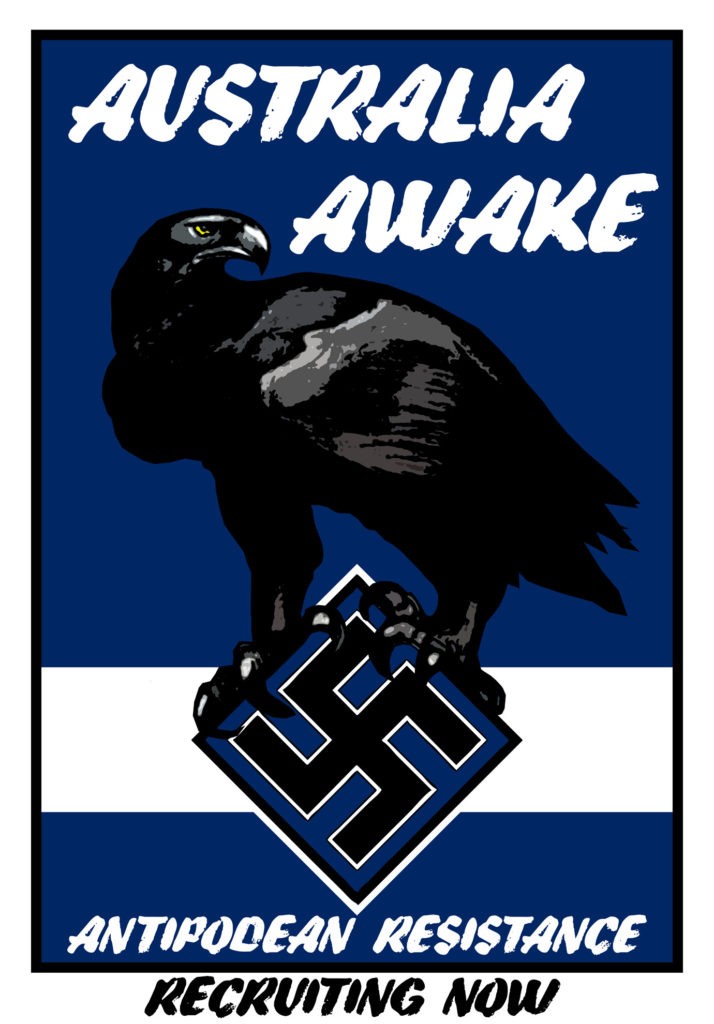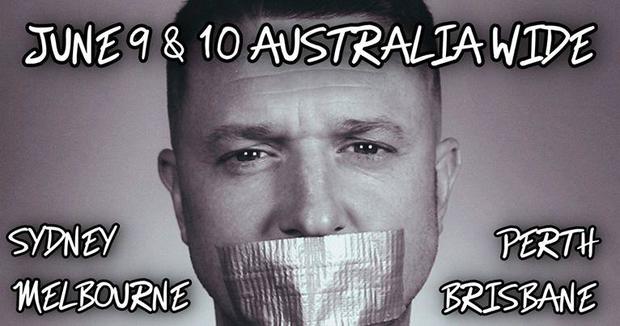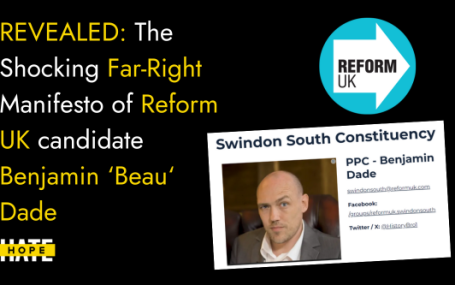HOPE not hate uses cookies to collect information and give you a more personalised experience on our site. You can find more information in our privacy policy. To agree to this, please click accept.
As in European nations, Australia is experiencing a growing anti-Islam, anti-immigrant sentiment, along with a clear nationalist and white protectionist agenda. In other ways, Australia is different. For example, there remains a latent prejudice against the Asian and Indigenous communities. The overtly fascist group Antipodean Resistance employed a campaign against Chinese students at the University of Melbourne last year, which indicates that elements of the Australian far right remain preoccupied with traditional targets alongside those who are focused on a new common enemy.
Australia has not yet experienced the same levels of coordination and mobilisation across extreme right-wing groups as in Europe or the US. However, it would be prudent to identify where the fault lines are in order to pre-empt the groups’ evolution. For example, a movement is growing in Australia, fronted by groups and individuals who campaign against what they perceive as the threat of Islamic culture, that are comparable to anti-Muslim groups such as Pegida or the ‘identitarian’ youth movement Generation Identity which are active in Europe and organisations like ACT! for America in the US.
Meanwhile, groups such as the Australian Liberty Alliance (a right-wing populist party), Reclaim Australia and Blair Cottrell’s United Patriots Front (UPF) use a strategy of victimisation and demonisation, rooted in the promotion and protection of Eurocentric culture and ‘Australian values’, to communicate their aims and objectives rather than by espousing overt white supremacist racism.
Different events in Australia’s political timeline have given rise to different waves of extremism. According to the Australian Institute for Criminology, the first Australian right-wing extremist groups, such as the ex-soldiers’ fascist movement known as the White Army, appeared in Australia after World War I. After World War II, a range of neo-Nazi groups targeted the Jewish population and Aboriginal Australians. During the 1980s, Australia experienced a rise in extreme right violence, which coincided with a national economic recession and the arrival of 120,000 refugees from Southeast Asia – the first large wave of ethnic minority immigrants since the dismantling of the White Australia policy. High interest rates and high levels of unemployment combined with widespread discontent over immigrants from ethnic minority backgrounds provided fertile ground for fear politics and hate speech to take root. Far-right violence escalated, resulting in a series of attacks including brutal assaults and fire bombings. As a result, the 1989 annual report of the Australian Security Intelligence Organisation (ASIO) warned that ‘the only discernible domestic threat of politically motivated violence comes from the racist right.’
Fast forward to a post-9/11 political environment, and a series of global events have again created a climate of fear and insecurity, allowing a new wave of far-right extremism to flourish: the advent of international Salafi-jihadi terrorism; the Iraq and Afghanistan wars; the international financial crash; the Syrian civil war; Islamic State’s self-declared caliphate, foreign fighters and lone-actor terrorism; and the global migration crisis.
As a result of this socio-political backdrop, over the past decade, a range of groups have emerged whose main focus is on the perceived threat posed by Muslims and migrants from Arab or African countries. These groups have managed to intertwine the threat posed by international terrorists with an alleged influence of Islamic cultural values on Australian society. They have a strong focus on disseminating propaganda and conspiracy theories about Islam and Muslims, such as linking halal certification of food to terrorist financing (a 2015 parliamentary inquiry into this alleged issue found no evidence of any such links). These groups include the Australian Settlers Rebellion, Patriot Blue, Restore Australia, Nationalist Alternative, United Patriots Front (Fortitude), True Blue Crew, Q Society (the social group aligned with Australian Liberty Alliance) and Soldiers of Odin. Rather than propagating overt neo-nazi or biological racist sentiments, these groups form part of a ‘new far right’ which is characterised by ‘a defiant, aggressive defense of national culture and history in the face of a changing world of secularism, democracy and liberty’. These groups have mushroomed out of each other, with individuals breaking away from one to start another due to ideological disagreements or simply as a result of internal spats.
The shifting dynamics of the extreme right towards an anti-Muslim stance has been corroborated by the Australian security services. ASIO’s 2016-2017 annual report concluded that Muslim communities in Australia are very likely to be targeted by proponents of extreme right violence. In June 2016, for example, a firebomb exploded outside Thornlie mosque in Perth during prayer time. This followed two attempted arson attacks on Toowoomba mosque in Brisbane in 2015.
There are, of course, a variety of far-right extremist groups active in Australia, with differing ideological bases. In addition to the newer groups focused on anti-Islam, there are the older-style far right extremist groups whose rhetoric is explicitly neo-Nazi and who opt for a clear white supremacist, antisemitic ideology. These groups include Antipodean Resistance, Reclaim Australia, Aryan Nations and Expel the Parasite. Others are outlets for the sexism and misogyny that has been known to infuse the extreme right. Founded by former UPF member Thomas Sewell, The Lads Society is an ‘exclusive men’s club’ that focuses on fitness and resourcefulness, and encourages their members to aspire to achieve ‘alpha male’ status.

Antipodean Resistance, in particular, is a group to watch closely. Although they do not currently engage in physical violence, and also deny inciting or promoting terrorism, Antipodean Resistance is known to have had connections to the now-banned UK terrorist organisation, National Action, as well as Atomwaffen Division in the US and the Nordic Resistance Movement in Norway, Sweden and Finland whose members were convicted of carrying out three bomb attacks in November 2016 and January 2017.
Right-wing populists add another dimension to the spectrum. Some groups – or individuals – have combined a growing disillusionment with mainstream left-wing liberal policies such as multiculturalism and mass immigration, with the perceived threat of the ‘Islamisation of Australia’. This has created a set of common goals between some fringe extreme right groups and political parties who share radical and extreme right-wing aims and objectives.
For example, George Christensen, a Nationals MP since 2010, openly praised Reclaim Australia, attended their rallies and defended their principles, alongside the notoriously bigoted politician and One Nation leader, Pauline Hanson, in 2015. More recently, the newly elected Senator for Katter’s Australia Party, Fraser Anning,recent praised the nation’s White Australia Policy in his maiden speech to the Senate, as well as employed the term ‘final solution’ and implored a plebiscite to end immigration from all Muslim, third world and non-English speaking nations.
Although Anning’s comments in the Senate were widely condemned by MPs, he garnered support for his version of the Trumpian ‘Muslim ban’ from Hanson and others. The fact that mainstream politicians are adopting the language, perspectives and policies of extreme far-right movements (such as UPF or Reclaim Australia) is incredibly dangerous and worrying. The boundaries of what constitutes ‘extreme’ are being shifted, particularly on social policy issues such as immigration, as the line between right-wing populists, right wing extremists and right-of-centre parties appears to be blurring.

An additional concern lies in the influence of international far-right extremists on the Australian environment. The #FreeTommy campaign is a good case study to illustrate the potential of cross-ideological, interstate and international cooperation and mobilisation of disparate groupings across the far right spectrum. Drawing some parallels with tech-savvy proponents of Salafi-jihadi extremism, far-right extremist groups and individuals have weaponised internet culture for their own strategic goals. Members of different groups have repackaged shared grievances, ‘to appeal to a wide range of audiences and cement a more cohesive ideology’. Groups such as Reclaim Australia, Australian Liberty Alliance and Q Society were mobilised by an online campaign propelled by the international Alternative Right, which called for the release of former English Defence League (EDL) leader Stephen Yaxley-Lennon (AKA Tommy Robinson), who was jailed in the UK. Hundreds of supporters marched across six cities in Australia on the same day that thousands marched in London, The Hague and other cities worldwide. This was the first time that the mobilisation potential of the so-called international Alternative Right had demonstrated an impact on the Australian far right.
However, this campaign is also a good case study for demonstrating how online engagement does not necessarily translate into offline action at the same scale: although there was substantial engagement across Reclaim Australia’s and the Australian Liberty Alliances’ Facebook pages, with one video viewed more than 400,000 times, only about 250 people mobilised offline in protests on the ground. Furthermore, before its Facebook page was removed in May 2017, the UPF had 120,000 likes, and UPF chairman Blair Cottrell’s currently active Twitter profile has more than 20,000 followers, but the UPF’s largest rally to date drew 600–1,000 supporters to Bendigo in 2015 to protest the building of a mosque. This demonstrates that online group ‘membership’ does not necessarily translate to offline action. This further indicates that there is a distinct lack of coordination between online activism and offline action, making it difficult to discern the actual nature of the threat posed.
Although the influence and threat of far-right extremism in Australia should not be overstated, it remains clear that there does exist a real and growing threat. ASIO’s last seven annual reports confirm a distinct rise in the activity of far-right extremist groups and has stated that the far right is likely to have a tangible effect on Australia’s security environment. Indeed, in 2016, Australia saw the first conviction of an individual under terrorism legislation for far-right motivated violence. The trajectory of far-right motivated violence in Australia suggests that this may not be an isolated incident, and security personnel need to be prepared for the possibility of further violence in the future.
1. Groups included the Australia First Movement (1930s); Nazi National Socialist Party of Australia / National Front of Australia (1960s); Australian National Alliance (1970s); National Action (neo-Nazi) and Blood & Honour (1980s); Australian Nationalist Movement (1990s); and Australia First Party 1996.↩
This piece was originally published on September 9, 2018 in the Ctrl Alt-Right Delete newsletter. To read the full September 9 Ctrl Alt-Right Delete in which it appeared, click here.

A Reform Party candidate fantasised about deporting “millions” of British citizens to “rid itself of the foreign plague we have been diseased with”. UPDATE: Reform…